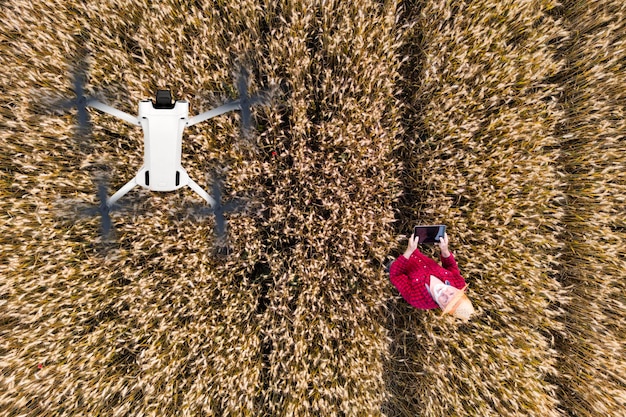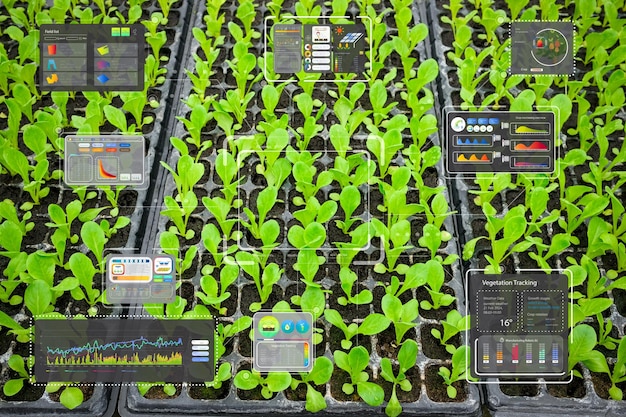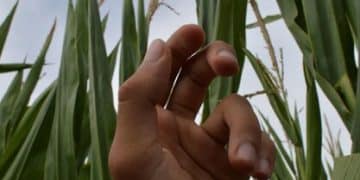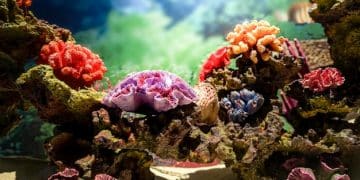AI in Agriculture: Optimizing Crop Yields and Reducing Pesticide Use by 15%

Artificial Intelligence in agriculture is poised to revolutionize farming by enabling unprecedented precision in crop management, leading to significant increases in crop yields and a targeted 15% reduction in pesticide use through intelligent monitoring and localized interventions.
The agricultural landscape is continuously evolving, seeking innovative solutions to global food demand and environmental sustainability. In this quest, artificial intelligence in agriculture: how can AI optimize crop yields and reduce pesticide use by 15% emerges as a transformative force, promising to reshape how we cultivate our food while mitigating ecological impact. This exploration delves into the precise mechanisms by which AI is not just a technological advancement, but a direct catalyst for more efficient and sustainable farming practices.
The Dawn of Smart Agriculture: AI’s Foundational Role
Smart agriculture, at its core, represents a paradigm shift from traditional, broad-stroke farming methods to data-driven, precision-oriented approaches. Artificial intelligence stands as the central nervous system of this revolution, processing vast quantities of information to provide actionable insights. By leveraging AI, farmers can move beyond intuition and generalized practices, adopting hyper-localized strategies for managing their crops.
The integration of AI begins long before seeds are even planted. Advanced AI models analyze historical weather patterns, soil composition, and topographical data to recommend optimal crop placement and planting times. This initial phase alone can significantly impact potential yields by ensuring crops start their life cycle under the most favorable conditions. This proactive approach minimizes early-stage risks and establishes a robust foundation for growth.
Predictive Analytics for Informed Decision-Making
One of AI’s most powerful contributions to agriculture comes in the form of predictive analytics. AI algorithms can forecast future conditions, from disease outbreaks to pest infestations, with remarkable accuracy. This foresight allows farmers to implement preventive measures rather than reactive ones, often before any visible damage occurs.
- Proactive Disease Management: AI identifies early signs of crop diseases from subtle changes in plant imagery, enabling targeted treatment.
- Pest Forecasting: Machine learning models analyze weather, pest migration patterns, and crop health data to predict outbreaks.
- Yield Prediction: Combining historical yield data with real-time field conditions helps farmers anticipate harvest volumes and market readiness.
Such predictive capabilities are instrumental in optimizing resource allocation, ensuring that interventions are timely and precise, rather than wasteful blanket applications. The ability to precisely pinpoint potential issues translates directly into healthier crops and reduced input costs.
Furthermore, AI-driven predictive models can simulate various scenarios, allowing farmers to understand the potential outcomes of different decisions before committing resources. This trial-and-error in a virtual environment saves time, money, and reduces exposure to risk, making farming a more predictable and financially stable enterprise.
The core concept here is prevention over cure, achieved through continuous data streams and intelligent processing. From preventing nutrient deficiencies to warding off invasive species, AI offers a robust shield for agricultural investments.
Optimizing Crop Yields Through Precision AI Applications
The promise of increased crop yields through AI is not merely theoretical; it is actively being realized through various precision applications. AI-powered systems enable an unprecedented level of granularity in monitoring and managing individual plants or specific zones within a field, moving away from uniform treatments that often neglect the diverse needs of different areas.
One primary mechanism for yield optimization is AI-driven irrigation systems. These systems use sensors to measure soil moisture levels in real-time, coupled with weather forecasts and crop-specific water requirements. AI algorithms then precisely control water delivery, ensuring each plant receives exactly the amount of water it needs, preventing both under-watering and over-watering. This not only conserves a precious resource but also promotes optimal plant growth, directly impacting yield.
Harnessing Computer Vision and Robotics
Computer vision, a branch of artificial intelligence, is revolutionizing how crops are monitored and managed. Drones equipped with high-resolution cameras and multispectral sensors capture detailed images of fields. AI algorithms then analyze these images to detect subtle variations in plant health, identify early signs of stress, nutrient deficiencies, or even the presence of individual weeds.
- Automated Plant Health Monitoring: AI analyzes drone imagery to assess vigor, chlorophyll levels, and identify stressed areas.
- Weed Detection and Mapping: AI can distinguish weeds from crops, creating precise maps for targeted removal.
- Phenotyping: Automated systems measure plant characteristics like height, leaf area, and fruit count, informing breeding programs.
Robotics, powered by AI, takes these insights a step further. Autonomous robots can navigate fields, performing tasks such as precision planting, targeted fertilizing, and selective harvesting based on AI analysis. These robots can work tirelessly and with incredible accuracy, reducing reliance on manual labor while improving the consistency and quality of agricultural operations. The synergy between computer vision and robotics allows for a highly automated and optimized farming process, significantly boosting productivity per acre.

The application of AI in phenotyping, for example, allows for accelerated development of new crop varieties with improved resilience and higher yields. By quickly identifying desirable traits, plant breeders can reduce years, even decades, from the crop development cycle. This iterative improvement driven by AI promises a future with more robust and productive crops, inherently leading to higher yields without necessarily expanding farmland.
Reducing Pesticide Use by 15%: AI’s Targeted Approach
The targeted goal of reducing pesticide use by 15% (or more) is a critical objective for sustainable agriculture, and AI is uniquely positioned to achieve this. Traditional farming often relies on prophylactic, broad-spectrum pesticide applications, which can harm beneficial insects, impact soil health, and contribute to environmental pollution. AI enables a paradigm shift to precision pest management, where pesticides are only applied when and where absolutely necessary.
The core of AI’s pesticide reduction strategy lies in its ability to identify and localize threats. Using sophisticated sensors, drones, and ground-based robots, AI systems can monitor fields for signs of pests or diseases. Rather than spraying an entire field, artificial intelligence pinpoints the exact coordinates of an infestation. This allows for spot treatment with minimal amounts of pesticides, drastically reducing the overall volume used.
Precision Spraying and Early Detection
When an AI system detects a localized pest problem, it can communicate this information to precision spraying equipment. These smart sprayers are equipped with nozzles that can be individually activated, applying pesticides only to the affected plants or even specific parts of those plants. This contrasts sharply with conventional sprayers that cover entire rows or fields, often hitting healthy plants and the surrounding environment unnecessarily.
Early detection is another cornerstone of pesticide reduction. AI algorithms can identify the very first signs of a pest or disease outbreak, often before they become widespread. Detecting issues at their nascent stage allows for the use of less potent treatments or even non-chemical interventions, preventing the need for more intensive chemical applications later. For instance, an AI might detect a single pest species in a small area, prompting manual removal or a tiny localized biological control agent, rather than a full-field chemical treatment.
AI’s role also extends to understanding pest behavior and life cycles. By analyzing environmental data, historical trends, and pest specific information, AI can predict when and where a pest is most likely to emerge or reproduce. This predictive capability allows for preventive measures or highly localized interventions before pest populations reach economic injury levels, further diminishing the overall need for pesticides.
The 15% reduction target is a conservative estimate given the capabilities of current AI technologies; in many cases, far greater reductions in pesticide use are achievable while maintaining or even improving crop health and yield. The economic benefits for farmers, coupled with the environmental advantages, make this one of the most compelling arguments for AI adoption in agriculture.
Data Analytics and Machine Learning in Agronomy
The power of artificial intelligence in agriculture stems from its ability to process and derive insights from massive datasets. Modern farming generates an unprecedented volume of data, from satellite imagery and drone scans to soil sensor readings and weather station reports. Machine learning algorithms, a subset of AI, are crucial for making sense of this data, transforming raw information into actionable agronomic intelligence.
Machine learning models can identify complex patterns and correlations that are invisible to the human eye. For example, by analyzing years of yield data alongside weather records, soil tests, and fertilizer application logs, an AI can develop highly accurate models for predicting optimal nitrogen application rates for specific soil types and crop varieties. This level of precision eliminates guesswork and wastage, ensuring resources are used most effectively.
Real-time Monitoring and Adaptive Farming
One of the most significant benefits of AI-driven data analytics is the enablement of real-time monitoring. Sensors placed throughout fields continuously collect data on parameters such as temperature, humidity, light intensity, and nutrient levels. This stream of real-time information allows AI systems to detect anomalies instantly and alert farmers to potential problems, whether it’s an irrigation system malfunction or the onset of drought stress.
- Continuous Data Collection: Sensors provide a constant stream of environmental and plant health data.
- Anomaly Detection: AI flags unusual patterns indicating issues like disease, pest activity, or equipment failure.
- Adaptive Adjustments: Farming operations can be modified on the fly based on real-time insights, optimizing conditions for plants.
This capability fosters an “adaptive farming” approach, where management practices can adjust dynamically to changing conditions. Instead of following a fixed schedule, farmers can respond precisely to the immediate needs of their crops. For example, if a sudden heatwave is detected, the AI system might recommend increased irrigation or temporary shade deployment. This agility significantly reduces risks and enhances resilience against unforeseen environmental challenges, ultimately safeguarding and boosting yields.
Furthermore, machine learning algorithms are continuously learning and improving. As more data is fed into the system, the models become more accurate and sophisticated. This iterative improvement means that AI systems in agriculture become increasingly valuable over time, delivering ever-more precise recommendations and forecasts. The ability to adapt and learn from new information is a hallmark of intelligent systems and a major advantage for the dynamic environment of agriculture.
Challenges and Future Prospects of AI in Agriculture
While the benefits of AI in agriculture are substantial, its widespread adoption is not without challenges. These include the high initial cost of AI-powered technologies, the need for robust data connectivity in rural areas, and the digital literacy gap among some farming communities. Ensuring data privacy and cybersecurity for sensitive farm data also presents a growing concern. Addressing these hurdles will be crucial for realizing AI’s full potential.
The initial investment for AI-enabled equipment, such as drones, autonomous tractors, and advanced sensor networks, can be prohibitive for small and medium-sized farms. Developing affordable, scalable solutions will be key to broader adoption. Additionally, many agricultural regions lack reliable high-speed internet access, which is essential for transmitting the vast amounts of data AI systems rely on. Governments and private entities must collaborate to expand digital infrastructure to these areas.
Despite these challenges, the future prospects for AI in agriculture are incredibly promising. Research is continuously advancing, leading to more sophisticated and user-friendly AI tools. We can anticipate the development of more specialized AI models that address specific regional challenges, such as drought resistance in arid zones or flood mitigation in low-lying areas. The integration of AI with other emerging technologies, such as advanced gene editing and nanotechnologies, could unlock unprecedented levels of precision and efficiency.

Towards Sustainable and Autonomous Farms
Looking ahead, the vision is of highly sustainable and increasingly autonomous farms. AI will play a central role in optimizing every aspect of the crop lifecycle, from seed to harvest, with minimal human intervention. This includes fully automated planting, monitoring, and harvesting systems that continuously adapt to environmental changes, ensuring optimal output with minimal resource input.
- Closed-Loop Systems: AI will manage integrated farm ecosystems, optimizing energy, water, and nutrient cycles.
- Hyper-Personalized Crop Care: Each plant could receive tailored treatment based on its individual needs.
- Global Food Security: AI can help address food security challenges by maximizing productivity and reducing waste on a global scale.
The drive towards sustainable agriculture will increasingly lean on AI to reduce ecological footprints. By optimizing fertilizer and water use, minimizing pesticide reliance, and improving energy efficiency, AI will help transform agriculture into a net positive contributor to environmental health. The goal of a 15% reduction in pesticide use is just a stepping stone; greater strides are entirely plausible as AI technologies mature and become more integrated into farming practices worldwide.
Moreover, AI has the potential to democratize access to advanced farming techniques, enabling smaller farms to compete more effectively and contribute significantly to global food production. Education and outreach programs will be vital to equip farmers with the knowledge and skills needed to leverage these powerful tools. Ultimately, AI’s role in agriculture is not just about technology; it’s about building a more resilient, productive, and sustainable food system for generations to come.
The Economic and Environmental Impact of AI in Farming
The economic and environmental impacts of integrating artificial intelligence into farming are profound and interconnected. Economically, AI promises to significantly boost profitability for farmers by increasing yields, reducing input costs, and minimizing losses due to pests, diseases, or adverse weather conditions. For consumers, this could translate into more stable food prices and higher quality produce due to more efficient and healthier cultivation practices. The reduction in the use of expensive inputs like pesticides, fertilizers, and water directly improves farmers’ bottom line, making their operations more financially viable and resilient to market fluctuations.
Furthermore, AI-driven insights can enable better market timing for crops, reducing post-harvest losses and ensuring produce reaches markets at peak freshness and demand. Efficiency gains from automated processes also lead to labor savings, although there is a concurrent need for new skills and roles within the agricultural workforce to manage these advanced technologies. The cumulative effect of these economic benefits is a more robust and sustainable agricultural industry, capable of meeting increasing global food demands.
Fostering Environmental Stewardship
From an environmental perspective, AI’s contributions are critical for fostering more sustainable and eco-friendly farming practices. The targeted reduction in pesticide use, as championed by AI systems, directly lessens the chemical load on ecosystems, protecting biodiversity, water sources, and soil health. This precision application minimizes runoff into rivers and groundwater, safeguarding aquatic life and human health.
Similarly, optimized water usage through AI-driven irrigation systems addresses the critical issue of water scarcity, particularly in drought-prone regions. By delivering water only where and when it’s needed, AI helps conserve this vital resource, reducing the environmental footprint of agricultural activities. Precise fertilizer application also mitigates nutrient runoff, preventing eutrophication of water bodies and reducing greenhouse gas emissions associated with excessive nitrogen use.
The overall reduction in resource consumption—be it water, chemicals, or energy (through optimized machinery routes)—contributes to a significantly lower carbon footprint for agriculture. AI-powered sustainable farming practices represent a vital step towards mitigating climate change, preserving natural resources, and ensuring long-term ecological balance. The environmental benefits extend beyond the farm, contributing to global biodiversity conservation and supporting healthier ecosystems for all.
The synergy between economic viability and environmental responsibility, facilitated by AI, positions smart agriculture as a key driver for a future where food production not only meets humanity’s needs but also harmonizes with the planet’s ecological imperatives. This holistic approach ensures that agricultural advancements serve both people and the planet, building a resilient and regenerative food system for generations to come.
| Key Point | Brief Description |
|---|---|
| 🌱 Precision Farming | AI uses data to optimize planting, irrigation, and fertilization, leading to healthier crops. |
| 🤖 Automated Monitoring | Drones and robots powered by AI detect pests/diseases early, allowing targeted intervention. |
| 📉 Pesticide Reduction | Targeted spraying based on AI analysis can reduce pesticide use by a significant margin. |
| 🌍 Eco-friendly Farming | Optimized resource use by AI enhances environmental sustainability in agriculture. |
Frequently Asked Questions
▼
AI optimizes crop yields through precision agriculture techniques. It analyzes vast datasets on soil conditions, weather patterns, and plant health from sensors and drones. This data allows AI to provide highly precise recommendations for irrigation, fertilization, and planting schedules, ensuring each plant receives optimal care tailored to its specific needs, ultimately leading to higher productivity and healthier crops.
▼
AI reduces pesticide use primarily through early detection and precision application. AI-powered systems can identify pests and diseases at their earliest stages and pinpoint their exact locations within a field. This allows for targeted, localized spraying rather than broad, indiscriminate application, significantly cutting down the overall volume of pesticides needed, minimizing environmental impact and treatment costs for farmers.
▼
Common AI technologies in agriculture include machine learning for predictive analytics (e.g., yield forecasting, disease prediction), computer vision for monitoring plant health and identifying anomalies via drones or robotic systems, and robotics for autonomous tasks like planting, weeding, and harvesting. These technologies work in tandem to provide comprehensive data analysis and automated operational capabilities.
▼
Yes, initial implementation of AI in farming can involve significant upfront costs, including investments in sensors, drones, autonomous machinery, and software systems. However, these costs are often offset by long-term savings from reduced resource consumption (water, pesticides, fertilizers) and increased yields, leading to a strong return on investment over time. Affordability and accessibility are ongoing areas of development.
▼
AI significantly contributes to environmental sustainability by optimizing resource use. It ensures water is used efficiently through smart irrigation, minimizes chemical runoff by enabling precision pesticide and fertilizer application, and can even reduce carbon emissions through optimized machinery routes. This leads to healthier ecosystems, preserved biodiversity, and a smaller overall ecological footprint for agricultural practices.
Conclusion
The transformative potential of artificial intelligence in agriculture is undeniable, offering a sophisticated pathway to address some of the most critical challenges facing global food production today. From the intricate optimization of crop yields through precise resource management to the substantial, targeted reduction in pesticide use, AI stands as a pivotal technology for a more sustainable and productive agricultural future. While challenges related to cost, connectivity, and digital literacy persist, the ongoing innovation in AI is steadily making these solutions more accessible and impactful. As we move forward, the continued integration of AI promises not only to feed a growing population more efficiently but also to safeguard the health of our planet, fostering an era of intelligent, eco-conscious farming.





